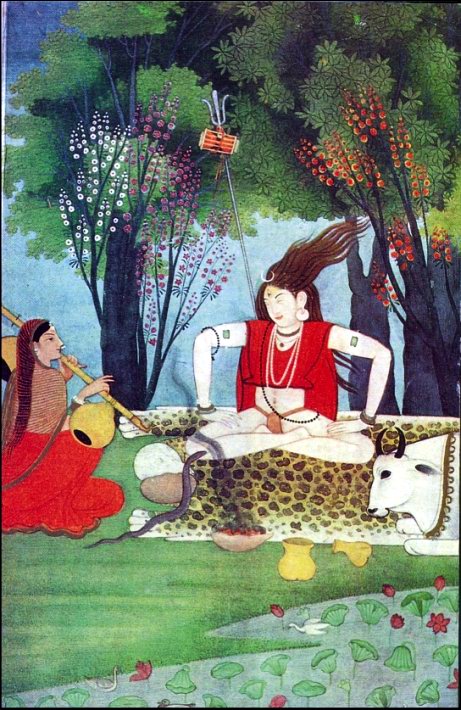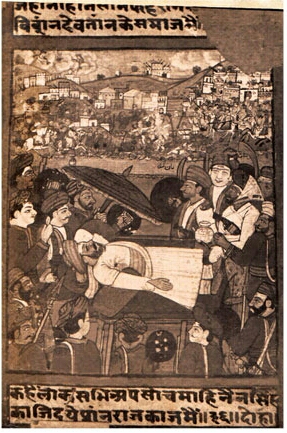Mola Ram on:
[Wikipedia]
[Google]
[Amazon]
Mola Ram or Maula Ram (1743–1833), p.119 was an Indian painter, who originated the Garhwal branch of the Kangra school of painting., pp.75–76 He was also a poet, historian and diplomat., p.25 Mukandi Lal did research on him.
 It is said, p.129 that two miniature painters of the Mughal imperial court at Delhi, Sham Das and his son Har Das (or Kehar Das), accompanied Sulaiman Shikoh, the son of
It is said, p.129 that two miniature painters of the Mughal imperial court at Delhi, Sham Das and his son Har Das (or Kehar Das), accompanied Sulaiman Shikoh, the son of  He wrote the historical work ''Garhrajvansh Ka Itihas'' (History of the Garhwal royal dynasty) which is the source of information about several Garhwal rulers. He starts with Shyam Shah and goes on to describe Dularam Shah, Mahipati Shah, Pritam Shah, Medini Shah, Lalit Shah, and Jayakrit Shah. He also wrote ''Ganika Natak'' or ''Garh Gita Sangram'' in 1800. Mola Ram himself played a part in politics, helping Jayakrit Shah obtain help from Raja Jagat Prakash of Sirmur to quell a rebellion at the battle of Karparoli.
Mola Ram wrote ''Garhrajvanshkavya'', ''Ran Bahadur Chandrika'', ''Shamsher-e-Jang Chandrika'', ''Bakhtawar Yash Chandrika'' and others. When Kaji Bakhtawar Singh Basnyat reached
He wrote the historical work ''Garhrajvansh Ka Itihas'' (History of the Garhwal royal dynasty) which is the source of information about several Garhwal rulers. He starts with Shyam Shah and goes on to describe Dularam Shah, Mahipati Shah, Pritam Shah, Medini Shah, Lalit Shah, and Jayakrit Shah. He also wrote ''Ganika Natak'' or ''Garh Gita Sangram'' in 1800. Mola Ram himself played a part in politics, helping Jayakrit Shah obtain help from Raja Jagat Prakash of Sirmur to quell a rebellion at the battle of Karparoli.
Mola Ram wrote ''Garhrajvanshkavya'', ''Ran Bahadur Chandrika'', ''Shamsher-e-Jang Chandrika'', ''Bakhtawar Yash Chandrika'' and others. When Kaji Bakhtawar Singh Basnyat reached
Mola Ram, Garhwal Paintings and Garhwal School of Painting
The story of Mola Ram
{{DEFAULTSORT:Ram, Mola Indian male painters 1743 births 1833 deaths 18th-century Indian painters 19th-century Indian painters People from Uttarakhand Painters from Uttarakhand People from Pauri Garhwal district 19th-century Indian male artists
Life and career
He was born inSrinagar
Srinagar (; ) is a city in Indian-administered Jammu and Kashmir in the disputed Kashmir region.The application of the term "administered" to the various regions of Kashmir and a mention of the Kashmir dispute is supported by the tertiary ...
(now in Uttarakhand
Uttarakhand (, ), also known as Uttaranchal ( ; List of renamed places in India, the official name until 2007), is a States and union territories of India, state in North India, northern India. The state is bordered by Himachal Pradesh to the n ...
) to Mangat Ram and Rami Devi and worked for the Garhwal Kingdom from 1777 until its annexation first by the Gorkhas in 1803 followed by the British Raj
The British Raj ( ; from Hindustani language, Hindustani , 'reign', 'rule' or 'government') was the colonial rule of the British The Crown, Crown on the Indian subcontinent,
*
* lasting from 1858 to 1947.
*
* It is also called Crown rule ...
in 1815. It is said, p.129 that two miniature painters of the Mughal imperial court at Delhi, Sham Das and his son Har Das (or Kehar Das), accompanied Sulaiman Shikoh, the son of
It is said, p.129 that two miniature painters of the Mughal imperial court at Delhi, Sham Das and his son Har Das (or Kehar Das), accompanied Sulaiman Shikoh, the son of Dara Shikoh
Dara Shikoh (20 March 1615 – 30 August 1659), also transliterated as Dara Shukoh, was the eldest son and heir-apparent of the Mughal emperor Shah Jahan. Dara was designated with the title ''Padshahzada-i-Buzurg Martaba'' () and was favoured ...
, when he escaped from his uncle Aurangzeb
Alamgir I (Muhi al-Din Muhammad; 3 November 1618 – 3 March 1707), commonly known by the title Aurangzeb, also called Aurangzeb the Conqueror, was the sixth Mughal emperors, Mughal emperor, reigning from 1658 until his death in 1707, becomi ...
in 1658 and sought refuge from Prithvi Shah of the Garhwal Kingdom, which had its capital in Srinagar. The painters remained in Srinagar as the royal ''tasbirdar'' (picture-makers), and developed the Garhwal style of miniature painting. Mola Ram was one of their descendants. The inception of the Garhwal school of painting is also sometimes credited to him. His son Jwala Ram and grandson Atma Ram continued the tradition, but further descendants suspected a curse and gave up painting. However, one of his descendants, Tulsi (often confused with Tulsi Mistri, another contemporary painter) was also a painter.
Mola Ram worked during the times of Garhwal rulers Pradip Shah, Lalit Shah, Jayakrit Shah and Pradyumna Shah from 1777 to 1804. He continued to work for the development of art and literature during the period of the Gorkha rule (1803–15) and the British rule over Garhwal.
Mola Ram himself initially painted in the Mughal style until visiting Kangra, e.g. his painting ''Mastani'' is in the Mughal idiom, while his later paintings, e.g. ''Vasakasajja Nayika'', are in the Garhwal style, and can be called Garhwali Paintings
Painting is a visual art, which is characterized by the practice of applying paint, pigment, color or other medium to a solid surface (called "matrix" or " support"). The medium is commonly applied to the base with a brush. Other implements, ...
in true sense. Some of his paintings are signed.
 He wrote the historical work ''Garhrajvansh Ka Itihas'' (History of the Garhwal royal dynasty) which is the source of information about several Garhwal rulers. He starts with Shyam Shah and goes on to describe Dularam Shah, Mahipati Shah, Pritam Shah, Medini Shah, Lalit Shah, and Jayakrit Shah. He also wrote ''Ganika Natak'' or ''Garh Gita Sangram'' in 1800. Mola Ram himself played a part in politics, helping Jayakrit Shah obtain help from Raja Jagat Prakash of Sirmur to quell a rebellion at the battle of Karparoli.
Mola Ram wrote ''Garhrajvanshkavya'', ''Ran Bahadur Chandrika'', ''Shamsher-e-Jang Chandrika'', ''Bakhtawar Yash Chandrika'' and others. When Kaji Bakhtawar Singh Basnyat reached
He wrote the historical work ''Garhrajvansh Ka Itihas'' (History of the Garhwal royal dynasty) which is the source of information about several Garhwal rulers. He starts with Shyam Shah and goes on to describe Dularam Shah, Mahipati Shah, Pritam Shah, Medini Shah, Lalit Shah, and Jayakrit Shah. He also wrote ''Ganika Natak'' or ''Garh Gita Sangram'' in 1800. Mola Ram himself played a part in politics, helping Jayakrit Shah obtain help from Raja Jagat Prakash of Sirmur to quell a rebellion at the battle of Karparoli.
Mola Ram wrote ''Garhrajvanshkavya'', ''Ran Bahadur Chandrika'', ''Shamsher-e-Jang Chandrika'', ''Bakhtawar Yash Chandrika'' and others. When Kaji Bakhtawar Singh Basnyat reached Srinagar
Srinagar (; ) is a city in Indian-administered Jammu and Kashmir in the disputed Kashmir region.The application of the term "administered" to the various regions of Kashmir and a mention of the Kashmir dispute is supported by the tertiary ...
on 1867 V.S. (i.e. 1810 A.D.), Mola Ram described the Gorkhali administration since 1861 V.S. (i.e. 1804 A.D.). In appreciation of Mola Ram's works, Kaji Bakhtawar gave 61 gold sovereigns, a horse, a robe, some weapons and restored his jagir
A jagir (), ( Hindustani: जागीर/جاگیر, ''Jāgīr''), ( Marathi: जहागीर, ''Jahāgīrá'') also spelled as jageer, was a type of feudal land grant in the Indian subcontinent at the foundation of its Jagirdar ( Zamindar ...
villages and daily allowances. Mola Ram dedicated ''Bakhtawar Yash Chandrika'' in praises of Kaji Bakhtawar Singh Basnyat. He also wrote about the past, present, and future of the Gorkhali administration in Kumaon and Garhwal, which had predicted the possible collapse of Gorkhali rule as mentioned in his another work ''Garhrajvanshkavya''.
Mola Ram died in Srinagar
Srinagar (; ) is a city in Indian-administered Jammu and Kashmir in the disputed Kashmir region.The application of the term "administered" to the various regions of Kashmir and a mention of the Kashmir dispute is supported by the tertiary ...
in 1833.
Tribute
A large collection of Mola Ram's paintings are preserved at the Hemwati Nandan Bahuguna Garhwal University Museum inSrinagar
Srinagar (; ) is a city in Indian-administered Jammu and Kashmir in the disputed Kashmir region.The application of the term "administered" to the various regions of Kashmir and a mention of the Kashmir dispute is supported by the tertiary ...
, Uttarakhand
Uttarakhand (, ), also known as Uttaranchal ( ; List of renamed places in India, the official name until 2007), is a States and union territories of India, state in North India, northern India. The state is bordered by Himachal Pradesh to the n ...
. Some of his paintings can also be viewed at the Boston Museum, USA, at the Bharat Kala Bhawan in Varanasi
Varanasi (, also Benares, Banaras ) or Kashi, is a city on the Ganges river in northern India that has a central place in the traditions of pilgrimage, death, and mourning in the Hindu world.*
*
*
* The city has a syncretic tradition of I ...
, and at the Kastur Bhai Lal Bhai Sagrahaalaya, Ahmedabad
Ahmedabad ( ), also spelled Amdavad (), is the most populous city in the Indian state of Gujarat. It is the administrative headquarters of the Ahmedabad district and the seat of the Gujarat High Court. Ahmedabad's population of 5,570,585 ...
.
Mukandi Lal wrote the book 'Garhwal Paintings' published by the Publications Division of the Government of India in 1968 which traced the history of Garhwal school of painting showcasing Mola Ram's various paintings and sketches.
References
Bibliography
* * * * * * *External links
Mola Ram, Garhwal Paintings and Garhwal School of Painting
The story of Mola Ram
{{DEFAULTSORT:Ram, Mola Indian male painters 1743 births 1833 deaths 18th-century Indian painters 19th-century Indian painters People from Uttarakhand Painters from Uttarakhand People from Pauri Garhwal district 19th-century Indian male artists